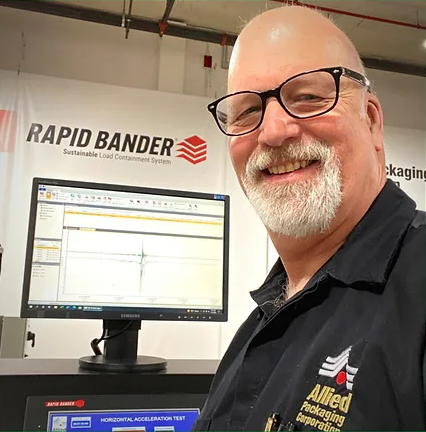Ask Steve
May 18, 2023
Question from Ally: How much film do we need to apply to a pallet of our product for good load containment?
Hi Ally, and thanks for your question. Let’s start by defining the role that stretch film plays in load containment, and then we can get into more specifics.
First and foremost, the job of the stretch film is to prevent movement of product throughout the load. So, by definition, it must resist the forces which are applied to the load during transport. This is achieved in two ways:
First, it must unitize the load by applying force, around the load, as the stretch retracts after application, preventing product movement. We call this “Force-to-Load”.
Second, it must resist stretching any further when transportation forces are applied to the load. We call any additional stretch which “loosens” the film’s containment “Secondary Stretch”.
Now that we understand the stretch film’s role, let’s move on to how much containment is wanted, or needed. Each load configuration has unique characteristics which affect what the stretch film does when forces are applied. Some of these are the packaging type (boxes, bags, bottles, etc.), the product weight, how tall the load is, how it is stacked on the pallet, whether tier sheets are used, generally how stable the load is prior to wrapping, and so on.
The cost of a pallet of your product is also a major load containment influencer. For example, if the product cost per pallet is low, you may have a higher tolerance for the cost of load failures (providing they are not too frequent), however, if your product cost is quite high, your tolerance for load failure will be very low (especially if there could be an environmental impact to clean up a load failure). To put it into perspective, if your product value is $50,000 per pallet, an extra $.50 per pallet of stretch film is more than justified to prevent load failure.
Your experience with the cost of load failures or rejected loads will determine if your current standards are adequate.
As a rule of thumb, I find that most companies apply far more film than is necessary, either from an abundance of caution or to minimize secondary stretch (prevent load failure). The more you stretch film, the stiffer it becomes, providing better load containment. However, as it stiffens it also becomes more brittle and the web will break easily. So, there is a limit to how much you can stretch conventional film, even high-performance films to get maximum resistance to secondary stretch. Material science defines that constraint. To overcome it, you typically apply more film, which works because each layer you apply is stretched, then grips or clings to the previous layer. With each additional layer, the effective thickness of the film you are applying is increased, multiplying its resistance to secondary stretch.
What if the film itself resisted that secondary stretch without the need to apply so many wraps? You would have the same, or better, containment, but now you would only use half the amount of conventional film, even high-performance film. Since material science and chemistry are the universal constraint, we have taken a completely unique approach to load containment with our Rapid Bander, Rapid Roper, and Rapid Roper Plus applying basic physics. We use two rolls, with about the same total thickness of conventional film, one full web and one that has bands. Those bands are narrowed, rolling the edges to form filaments. The bands with their filaments are laminated into the full web as it passes through the pre-stretch rollers on your machine. They drastically increase the amount of stretch the film can withstand and will achieve maximum load containment performance, effectively eliminating secondary stretch without web breaks. Therefore, for the same level of containment, you will use about ½ or less than you would with conventional or high-performance films.
Now, let’s put all this together. Building on our new-found knowledge of load containment:
We know the role stretch film plays in load containment, it must apply a force-to-load and unitize your product and it must resist further stretch when transportation forces are applied.
We know that a load containment standard is a financial decision. The higher the product cost, the higher the load containment standard needs to be, because load failure must be avoided at all costs.
We know the resistance to secondary stretch is limited when using conventional, or high-performance films. The only way to increase resistance to secondary stretch is to apply more film.
However, using Rapid Bander, Rapid Roper, or Rapid Roper Plus, you can stretch the film further, achieving its peak level of load containment performance, and by eliminating secondary stretch it allows you to use about ½ the film you normally would.
We can help you work through the analysis to arrive at the right load containment for your specific need, and in the process, save you money. I also know that your company has a major focus on sustainability, and by cutting your stretch film usage in half without sacrificing load containment, you are a big step closer to that goal.
Thanks for asking!








